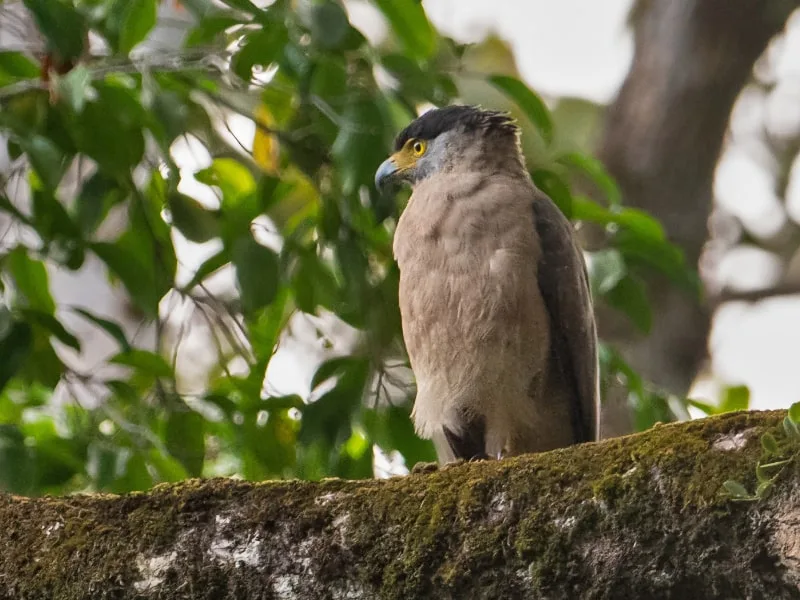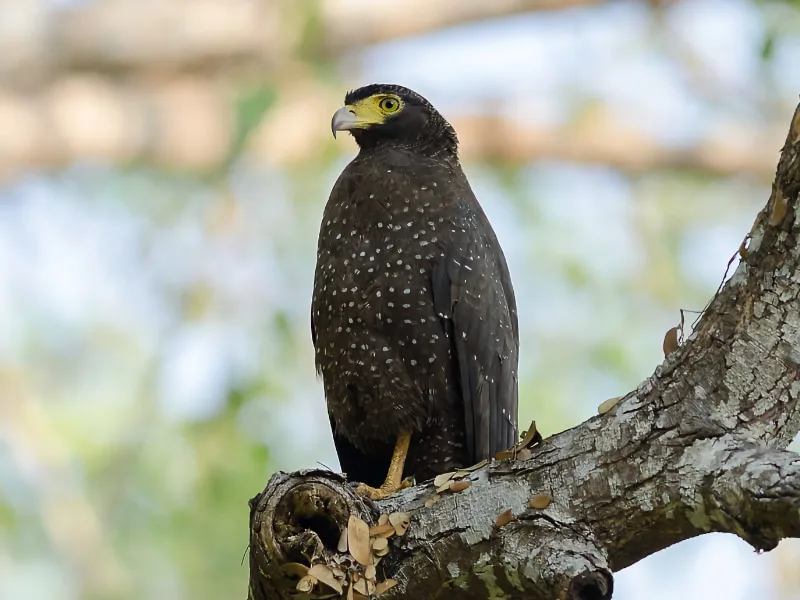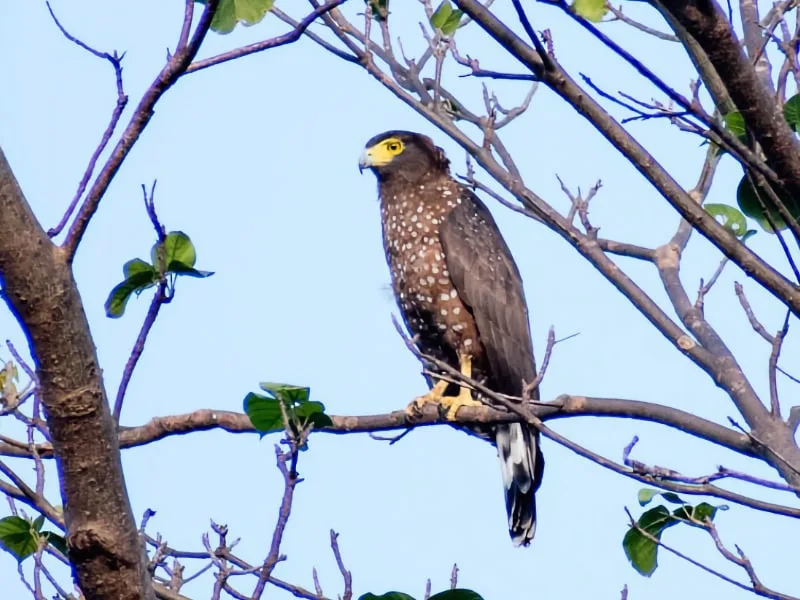The Great Nicobar serpent eagle (Spilornis klossi) is a little-known, island-endemic raptor confined to the dense forests of Great Nicobar and a few surrounding islands in the Indian Ocean. It is one of the world’s smallest eagles and among the rarest, with a limited population estimated at fewer than 200 mature individuals and a highly restricted range.
Despite its small stature, it plays a vital ecological role as a predator of reptiles and small animals within its tropical forest habitat. Due to ongoing habitat loss, ecological competition, and its naturally small population size, the Great Nicobar serpent eagle is classified as Endangered and remains one of the least-studied members of its genus.

| Common name | Great Nicobar serpent eagle |
| Scientific name | Spilornis klossi |
| Alternative names | South Nicobar serpent eagle, Nicobar serpent eagle |
| Order | Accipitriformes |
| Family | Accipitridae |
| Genus | Spilornis |
| Discovery | Collected by W. L. Abbott in 1901; formally described by C. W. Richmond in 1902 |
| Identification | Very small eagle with pale brown plumage, greyish head and throat, black crest, bright yellow facial skin, and unmarked pale underparts |
| Range | Endemic to Great Nicobar Island and nearby islands (Little Nicobar, Pulo Kunji, Menchal, Pilo Milo, Treis) |
| Migration | Non-migratory; sedentary and highly territorial within its forest habitat |
| Habitat | Mixed evergreen forest; most often seen in canopy; prefers dense, mature forest but occasionally found near clearings and water bodies |
| Behavior | Solitary and territorial; forages by perching and scanning; interacts minimally with other raptors |
| Lifespan | Estimated 10-15 years in the wild; potentially longer in captivity |
| Diet | Feeds mainly on reptiles (snakes and lizards), small mammals, and occasionally small birds |
| Conservation status | Endangered (IUCN) |
| Population | 150-370 mature individuals; best current estimate 150-180 individuals |
Discovery
The Great Nicobar serpent eagle was first documented during an expedition to the Nicobar Islands in 1901, led by the American naturalist William Louis Abbott. Abbott, accompanied by the British zoologist Cecil Boden Kloss, collected a series of bird specimens from Great Nicobar Island. Based on these collections, the species was formally described in 1902 by Charles Wallace Richmond of the United States National Museum. Richmond named the bird Spilornis klossi in honor of Kloss, recognizing his contributions to the zoological exploration of the Andaman and Nicobar archipelagos.
Following its original description, Spilornis klossi was often treated as a subspecies of the widespread crested serpent eagle (Spilornis cheela), under the name Spilornis cheela klossi. However, detailed studies of its morphology, vocalizations, and its geographic isolation led later taxonomists to recognize it as a distinct species. This treatment is now widely accepted by major ornithological authorities, including the International Ornithologists’ Union and BirdLife International.
Identification
The Great Nicobar serpent eagle is the smallest eagle in the world, measuring approximately 38-42 centimeters (15-16.5 inches) in length, with an estimated weight of around 450 grams (15.9 ounces) and a wingspan ranging from 85 to 95 centimeters (33.5-37.4 inches). It is distinguished by its compact size, black crest, and overall pale brown plumage.

The head and throat are greyish to bluish-grey, contrasting subtly with the brown-toned upper chest and nape. The underparts are distinctly paler and completely unmarked, lacking the spotting or barring seen in related species. Facial skin and cere are bright yellow, and the legs are similarly yellow and unfeathered. The beak is grey to bluish-grey and powerfully hooked. In flight, the species shows short, broad wings and a relatively short tail with a prominent black terminal band.
While males and females are similar in plumage, females are likely larger than males, following the typical pattern of sexual size dimorphism observed in serpent eagles, with females estimated to exceed males by approximately 10-12% in size.

Juveniles can be distinguished by their paler and lighter overall plumage, the absence of a fully developed black crest, and the lack of grey coloration on the head and throat that characterizes adults. Their upperparts appear more mottled and the facial pattern is softer, contributing to a generally less contrasted appearance compared to mature birds.
Vocalization
The call of the Great Nicobar serpent eagle is a high-pitched, whistled note, typically delivered singly or in short bursts. Compared to the loud and complex vocalizations of the crested serpent eagle, the sounds produced by the Great Nicobar serpent eagle are simpler and quieter, a reflection of its insular, forest-dwelling habits. Documented recordings are rare, and further study is needed to characterize the full range of its vocal behavior.
Range
The Great Nicobar serpent eagle is one of the most range-restricted eagles in the world. It is endemic to the southern Nicobar Islands, India, where it occurs only on Great Nicobar and a few nearby satellite islands, including Little Nicobar, Pulo Kunji, Menchal, Pilo Milo, and Treis. The total area of occupancy is estimated to be less than 1,000 square kilometers (386 square miles), confined to a narrow belt of tropical island forest within the Indian Ocean.

Records from the central Nicobar Islands, sometimes labeled under this species on public platforms, in fact refer to the taxon Spilornis minimus, which is more appropriately considered a subspecies of Spilornis cheela. As such, the range of S. klossi is entirely restricted to the southernmost islands of the Nicobar chain, with no confirmed overlap with other serpent eagle taxa in its core habitat.
Migration
There is no evidence of migratory or large-scale seasonal movements in the Great Nicobar serpent eagle. It is believed to be a resident, non-migratory species, maintaining a stable territory year-round. Dispersal capacity is likely very limited, with movements probably restricted to local shifts within the same island or to adjacent islets. The species’ extreme range confinement and ecological specificity further support the assumption of sedentary behavior.
Habitat
The Great Nicobar serpent eagle is a forest-dependent raptor that occurs primarily in mixed evergreen forests, favoring mature, undisturbed tracts with continuous canopy cover. It is most frequently observed in the upper canopy, either perched silently or gliding between trees. The species shows a marked preference for dense native forest but is occasionally seen at forest edges, in adjacent meadows, or near water bodies such as streams and ponds.
It typically inhabits areas from sea level up to 100 meters (330 feet) elevation but has been recorded as high as 600 meters (1,970 feet) above sea level in some parts of Great Nicobar Island. Despite these occasional excursions into more open habitats, S. klossi remains fundamentally tied to the closed-canopy forest for foraging, nesting, and territorial behavior.
Its strong dependence on undisturbed forest makes it highly vulnerable to habitat alteration. Fragmentation, logging, agricultural encroachment, and infrastructure development, particularly associated with expanding human settlement, pose significant threats to the survival of this specialized island endemic.
Behavior
The Great Nicobar serpent eagle is a predominantly solitary raptor, typically encountered alone or occasionally in pairs. Individuals are believed to maintain stable territories year-round, a behavior consistent with other Spilornis species inhabiting restricted island environments.
Daily activity patterns are diurnal, with the species most active during the early morning and late afternoon hours. During these periods, it can be seen soaring slowly above the forest canopy on broad, rounded wings or perched motionlessly in the upper branches of tall trees. Much of the day may be spent resting or scanning for prey from concealed perches, with short flights undertaken to change hunting sites or defend territory.

In terms of interspecific interactions, the Great Nicobar serpent eagle occupies the role of a mid-sized forest predator. Within its restricted range, it shares the habitat with other raptors such as the crested serpent eagle (Spilornis cheela), white-bellied sea eagle (Haliaeetus leucogaster), and brahminy kite (Haliastur indus), but differs by specializing in smaller terrestrial prey within dense forest interiors.
Being one of the smallest birds of prey of its group, the Great Nicobar serpent eagle may avoid direct competition with larger raptors by focusing on specialized forest habitats and targeting smaller prey types. No systematic observations of aggressive interactions with other bird species have been recorded, but like other serpent eagles, it may engage in territorial displays against conspecifics or potential predators approaching its hunting grounds.
Breeding
Breeding behavior of the Great Nicobar serpent eagle remains poorly documented, and no comprehensive field studies have been conducted on this aspect of its biology. However, based on observations of closely related Spilornis species and the ecological traits common among insular raptors, several cautious inferences can be made.
The species is believed to be monogamous, with pairs likely forming long-term bonds and defending permanent territories throughout the year. Although aerial courtship displays are characteristic of many raptors, soaring flights appear to be absent or minimal in S. klossi, a trait that would be consistent with its adaptation to dense, closed-canopy forest environments where such displays are less visible and less effective.
Nesting likely occurs in the upper canopy of tall trees, where the pair constructs a large stick nest concealed among branches. Clutch size is probably one or two eggs, as is typical for other serpent eagles. The eggs are assumed to be pale cream or white, possibly with light spotting.
Parental care is presumed to involve both sexes: the female likely undertakes incubation, while the male provides food during the incubation and early chick-rearing stages. Later, both parents may contribute to feeding the developing chick until fledging. Specific details such as incubation period, fledging time, and post-fledging dependence remain unknown for this species.
Lifespan
The Great Nicobar serpent eagle is expected to live approximately 10 to 15 years in the wild, based on observations of similar Spilornis species and other small tropical raptors. Individuals may live longer under human care, potentially reaching up to 30 years, although no captive lifespan records exist for this species. Juvenile mortality is presumed to be high, with survival improving significantly once territorial establishment occurs.
Primary mortality factors likely include habitat loss, extreme weather events such as cyclones, and predation on eggs and nestlings. Although direct human persecution has not been reported, habitat degradation from logging, infrastructure development, and settlement expansion presents a substantial indirect threat to population viability.
Diet
The Great Nicobar serpent eagle is a forest-adapted predator that primarily feeds on small vertebrates. Its diet consists mainly of reptiles, including snakes and lizards, supplemented by small mammals such as rodents and, to a lesser extent, small birds. The emphasis on reptiles aligns with the dietary specialization observed in other members of the Spilornis genus.
The species employs a sit-and-wait hunting strategy, perching motionlessly in the canopy or subcanopy and scanning the surrounding vegetation for prey movement. Once a target is located, it performs a swift, direct attack, either swooping onto the ground or capturing prey among the branches. Hunting typically occurs within the forest interior, although individuals may occasionally forage near forest edges or clearings. The reliance on dense vegetation for hunting reflects its adaptation to closed-canopy evergreen forests.
Threats and conservation
The Great Nicobar serpent eagle is currently classified as Endangered on the IUCN Red List, owing to its extremely restricted range and small estimated population. Surveys suggest that the global population likely numbers between 150 and 370 mature individuals, with recent density modeling favoring a lower estimate of 150-180 individuals.
Confined to less than 1,000 square kilometers (386 square miles) of tropical forest on a few islands in the southern Nicobars, the Great Nicobar serpent eagle is considered decidedly rare and less numerous than its close relative, the Andaman serpent eagle (Spilornis elgini). Based on current population estimates, it is regarded as the rarest eagle in the world, along with the Madagascar fish eagle (Icthyophaga vociferoides).
Threats
The primary threat to the Great Nicobar serpent eagle is habitat loss and degradation. Although forest cover loss within its range between 2000 and 2020 was relatively modest (around 4%), ongoing small-scale clearing for settlement, agriculture, and development remains a concern. Planned infrastructure expansion, especially projects aimed at boosting tourism, may further fragment and degrade the species’ critical forest habitat in the future.
The adaptability of other Spilornis species to habitat disturbance suggests that S. klossi may tolerate minor changes in its environment. However, its apparent dependence on dense, mature forest raises concerns that larger-scale or rapid habitat alterations could have more severe impacts. Additionally, competition with the more adaptable crested serpent eagle (S. cheela), which occurs in the Nicobar Islands at higher densities, may further constrain available habitat and resources for S. klossi.
No evidence currently suggests significant direct persecution or hunting of the species, but the cumulative effects of habitat loss and ecological competition could pose substantial risks to its already small and fragmented population.
Conservation efforts
No targeted conservation measures are currently known to be in place for the Great Nicobar serpent eagle. However, a significant portion of its habitat falls within the Great Nicobar Biosphere Reserve, which nominally provides some protection. The effectiveness of enforcement and the degree of protection afforded to the species within this reserve remain uncertain.
Conservation priorities for S. klossi include conducting dedicated field surveys to better estimate population size and distribution, assessing its adaptability to habitat change, and monitoring population trends. Strengthening protection efforts within the Biosphere Reserve, particularly against habitat clearance and unsustainable development, will be critical to ensuring the long-term survival of this insular eagle.
Similar species
The Great Nicobar serpent eagle (Spilornis klossi) may be confused with several other serpent eagle species due to similarities in size, plumage, and structure. Careful attention to range, body proportions, and plumage details is necessary to avoid misidentification, particularly where species overlap geographically or share ecological traits.
Crested serpent eagle (Spilornis cheela)

The crested serpent eagle occurs throughout the Indian subcontinent and Southeast Asia and is also present in the Nicobar Islands. It is significantly larger and bulkier than the Great Nicobar serpent eagle, with a heavier build, broader wings, and prominent spotting on the underparts. In contrast, S. klossi has plain, unmarked underparts and a more delicate structure, making size and plumage critical distinguishing features in the field.
Andaman serpent eagle (Spilornis elgini)

Restricted to the Andaman Islands, the Andaman serpent eagle is also substantially larger than the Great Nicobar serpent eagle, with a heavier body and broader wings. While both species share a forest-adapted lifestyle and similar structure, S. elgini exhibits dark brown plumage with prominent pale spotting on the underparts, in contrast to the plain, unmarked, and paler underparts of S. klossi. Although their ranges do not overlap, they present an important taxonomic comparison.
Philippine serpent eagle (Spilornis holospilus)

Native to the Philippines, this species resembles S. klossi in its small size and general proportions. However, S. holospilus typically displays more extensive spotting and barring on the body and wings, giving it a more patterned appearance than the plainer Great Nicobar serpent eagle. Geographic separation eliminates confusion in the field.
Mountain serpent eagle (Spilornis kinabaluensis)

Endemic to the montane forests of Borneo, the mountain serpent eagle shares a compact build and a dark, crested head with S. klossi. It is, however, found at higher elevations and exhibits heavier barring across the breast and flanks. Like the Philippine serpent eagle, it is separated geographically from S. klossi, and any resemblance is of taxonomic and morphological interest rather than practical field confusion.
Future outlook
The future of the Great Nicobar serpent eagle remains uncertain. With an estimated population of fewer than 200 mature individuals and a range restricted to less than 1,000 square kilometers (386 square miles) of tropical forest, the species faces an elevated risk of extinction from both natural and human-driven threats. Although recent forest loss within its range has been relatively low, ongoing pressures from settlement expansion, infrastructure development, and planned tourism projects could accelerate habitat degradation in the coming decades.
The species’ apparent dependence on intact evergreen forest raises particular concern, as even small-scale habitat fragmentation may disrupt its foraging and breeding activities. While some Spilornis species show adaptability to disturbed environments, it remains unclear whether S. klossi shares this resilience. In addition, the effects of competition with the more widespread and adaptable crested serpent eagle require further investigation.
Conservation efforts to date have been minimal, limited mainly to the nominal protection offered by the Great Nicobar Biosphere Reserve. Without targeted action, including robust population monitoring, habitat protection, and research into the species’ ecological flexibility, the Great Nicobar serpent eagle may continue to decline unnoticed. Given its extreme rarity and restricted distribution, proactive conservation planning is critical to secure the survival of one of the world’s smallest and rarest eagles.
Further reading
